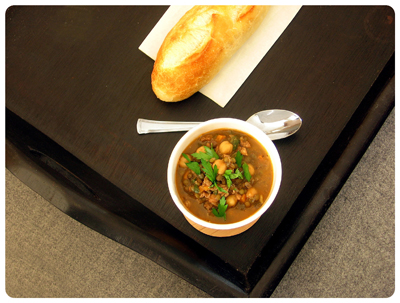A tantalizing portrait
 Monday, September 1, 2008 at 8:12AM
Monday, September 1, 2008 at 8:12AM 
Mark Bittman's tomato jam; wonderful to look at, tastes even better. Photos taken by my sister-in-law.
It was love at first sight. Or at least greed at first glance.
It was early. I was still in my pajamas and had only recently padded into the kitchen. Coffee in hand, I flicked open the newspaper and there it was. Across the countertop lay spread a photo so alluring, so beautiful, that my breath caught and I stopped mid sip.
Now what ever could have caught my rapt attention? What was the object of my early-morning desire, you ask?
Mark Bittman's Tomato Jam. (You know me well enough to know it would be about food.)
But seriously. Look at this. It is just a spoonful of gorgeousness. To call it red would be a disservice; it seems too plain. Scarlet doesn't cut it, brick doesn't even come close. Vermilion? Crimson? I cannot come up with an adjective that captures the particular hue of this luscious-looking stuff.
Attempts to describe aside, I did know one thing from the start. I wanted to try this jam. I needed to make it. And I needed to make it right away.
And so, I set about making a batch of tomato jam. Lucky for me, my dear Sean is used to the vagrancies of my behaviour and said not a word when I started mincing green chilies and ginger. After a minimal bit of chopping, stirring and grinding, on my stove sat a bubbling pot. Soon the smell of coffee met and mingled with scents of ripe tomatoes and grassy cumin, with an underlying warmth of cinnamon and clove.
The pot remained for the remainder of the coffee, and for the duration of breakfast. All the while deepening in colour and texture; what started out as bright and watery slowly turned darker, richer. In the end, I was left with a sticky sweet relish, heady with spice but with a good balance of acidity. It was complex without being overly complicated.
The jam was even better after it cooled overnight in the fridge. Akin to a chutney, it is an unexpected but delicious accompaniment to bread and cheese. I would offer more suggestions for its use, but I haven't gotten that far; I've just started exploring the possibilities.
I can tell you this though, this tomato jam looks good enough to eat. And its looks do not deceive.

Tomato Jam
By Mark Bittman, as published in the New York Times (August 19, 2008) and in syndication.
Recipe and an associated video are both available online.
Notes:
• I used a mix of tomatoes from our garden, all rather sweet in their own right. While I understand its role in setting the jam, I was still wary of the amount of sugar in the recipe - so I used a generous 3/4 of a cup and upped the tomatoes to a full 2 lbs.
• For another savory note I included 1 large garlic clove, grated.
• Wanting enough heat to cut through the sweetness, I used two small green chilies instead of the jalapeño.
• When I make this again I might include a bit of lime zest, if I'm so inclined.
• Most likely due to the reduced amount of sugar and additional tomatoes, my cooking time was closer to 2 hours to reach the consistency I was looking for.





















